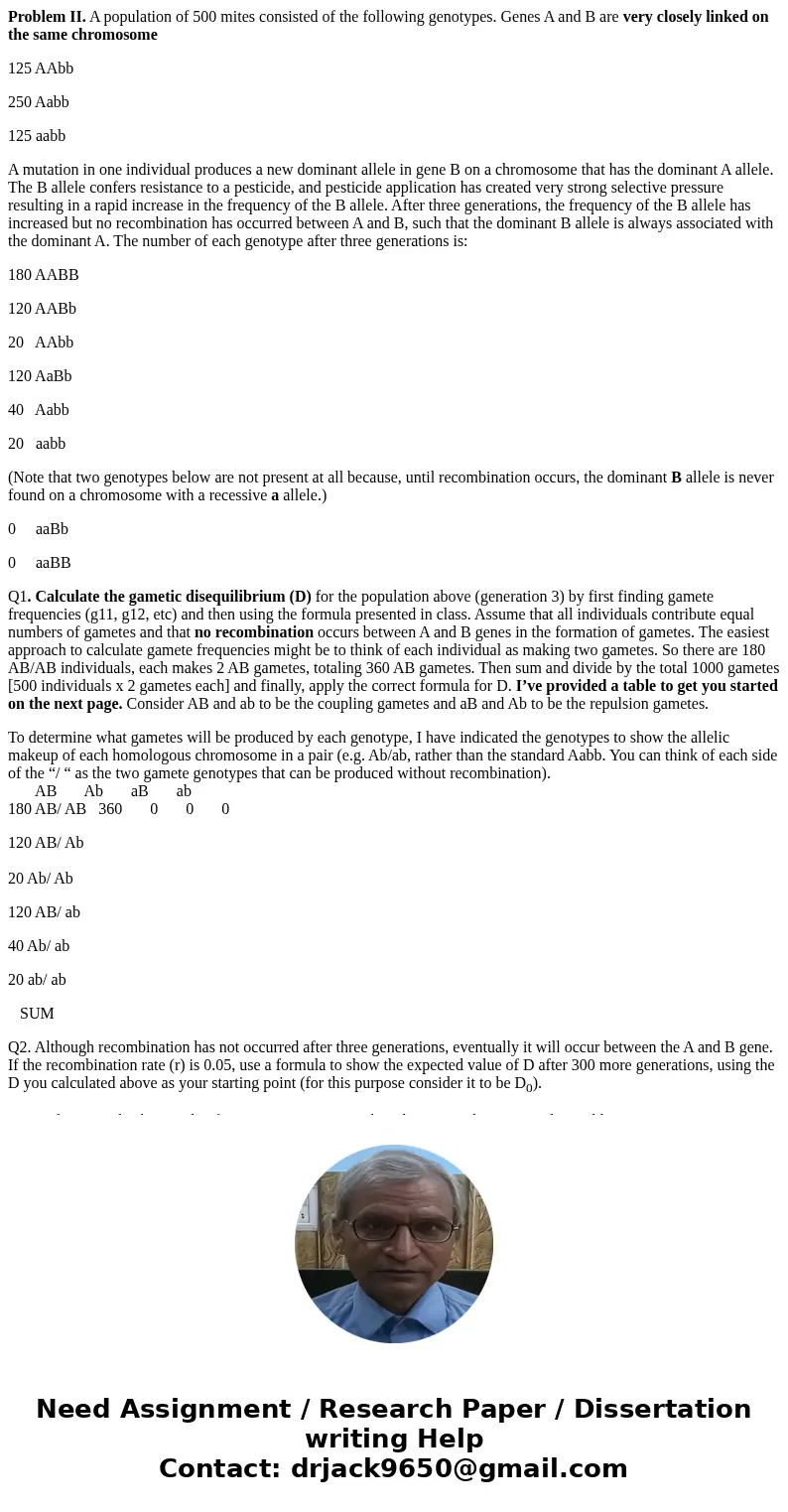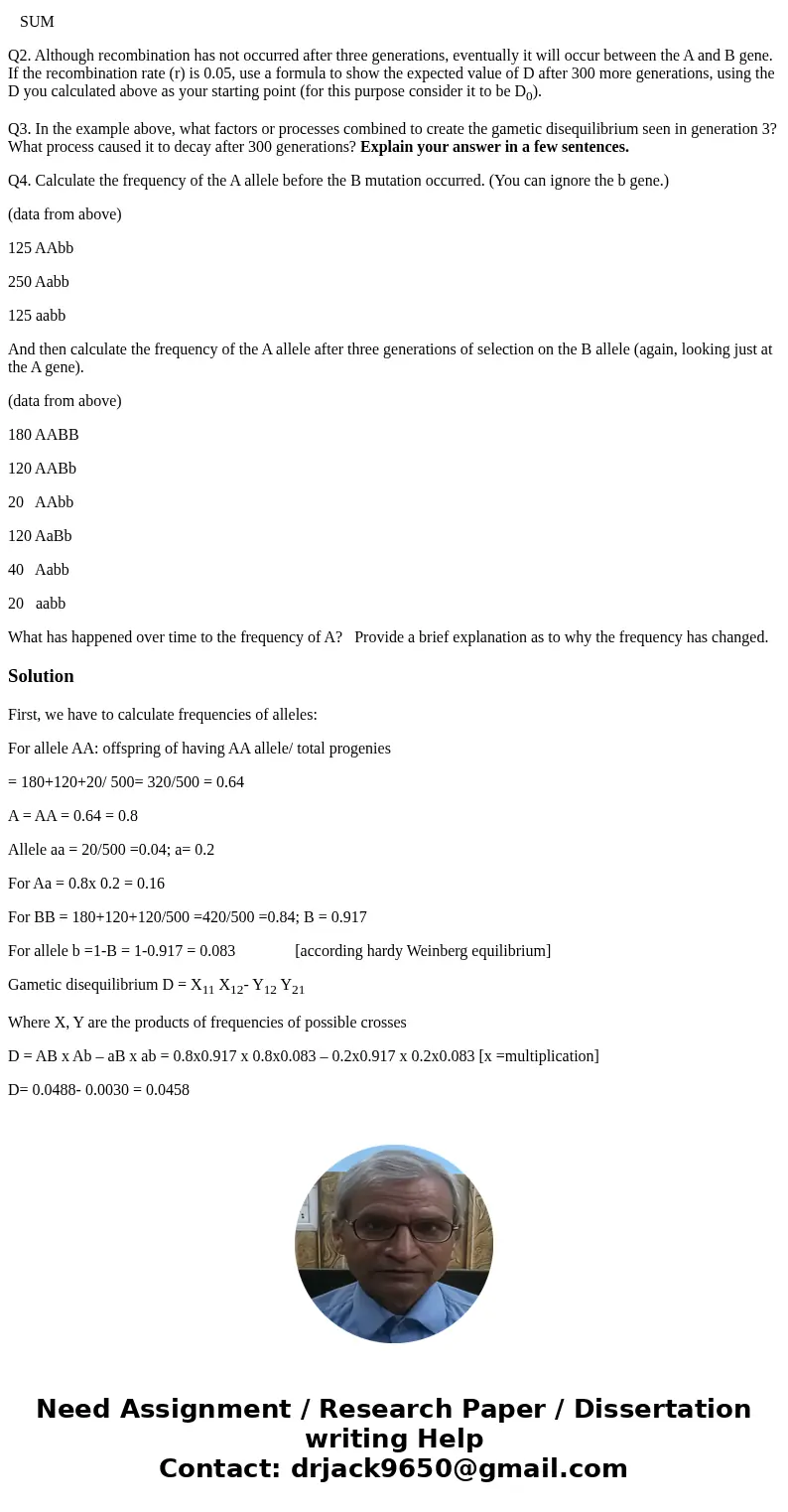Problem II A population of 500 mites consisted of the follow
Problem II. A population of 500 mites consisted of the following genotypes. Genes A and B are very closely linked on the same chromosome
125 AAbb
250 Aabb
125 aabb
A mutation in one individual produces a new dominant allele in gene B on a chromosome that has the dominant A allele. The B allele confers resistance to a pesticide, and pesticide application has created very strong selective pressure resulting in a rapid increase in the frequency of the B allele. After three generations, the frequency of the B allele has increased but no recombination has occurred between A and B, such that the dominant B allele is always associated with the dominant A. The number of each genotype after three generations is:
180 AABB
120 AABb
20 AAbb
120 AaBb
40 Aabb
20 aabb
(Note that two genotypes below are not present at all because, until recombination occurs, the dominant B allele is never found on a chromosome with a recessive a allele.)
0 aaBb
0 aaBB
Q1. Calculate the gametic disequilibrium (D) for the population above (generation 3) by first finding gamete frequencies (g11, g12, etc) and then using the formula presented in class. Assume that all individuals contribute equal numbers of gametes and that no recombination occurs between A and B genes in the formation of gametes. The easiest approach to calculate gamete frequencies might be to think of each individual as making two gametes. So there are 180 AB/AB individuals, each makes 2 AB gametes, totaling 360 AB gametes. Then sum and divide by the total 1000 gametes [500 individuals x 2 gametes each] and finally, apply the correct formula for D. I’ve provided a table to get you started on the next page. Consider AB and ab to be the coupling gametes and aB and Ab to be the repulsion gametes.
To determine what gametes will be produced by each genotype, I have indicated the genotypes to show the allelic makeup of each homologous chromosome in a pair (e.g. Ab/ab, rather than the standard Aabb. You can think of each side of the “/ “ as the two gamete genotypes that can be produced without recombination).
AB Ab aB ab
180 AB/ AB 360 0 0 0
120 AB/ Ab
20 Ab/ Ab
120 AB/ ab
40 Ab/ ab
20 ab/ ab
SUM
Q2. Although recombination has not occurred after three generations, eventually it will occur between the A and B gene. If the recombination rate (r) is 0.05, use a formula to show the expected value of D after 300 more generations, using the D you calculated above as your starting point (for this purpose consider it to be D0).
Q3. In the example above, what factors or processes combined to create the gametic disequilibrium seen in generation 3? What process caused it to decay after 300 generations? Explain your answer in a few sentences.
Q4. Calculate the frequency of the A allele before the B mutation occurred. (You can ignore the b gene.)
(data from above)
125 AAbb
250 Aabb
125 aabb
And then calculate the frequency of the A allele after three generations of selection on the B allele (again, looking just at the A gene).
(data from above)
180 AABB
120 AABb
20 AAbb
120 AaBb
40 Aabb
20 aabb
What has happened over time to the frequency of A? Provide a brief explanation as to why the frequency has changed.
Solution
First, we have to calculate frequencies of alleles:
For allele AA: offspring of having AA allele/ total progenies
= 180+120+20/ 500= 320/500 = 0.64
A = AA = 0.64 = 0.8
Allele aa = 20/500 =0.04; a= 0.2
For Aa = 0.8x 0.2 = 0.16
For BB = 180+120+120/500 =420/500 =0.84; B = 0.917
For allele b =1-B = 1-0.917 = 0.083 [according hardy Weinberg equilibrium]
Gametic disequilibrium D = X11 X12- Y12 Y21
Where X, Y are the products of frequencies of possible crosses
D = AB x Ab – aB x ab = 0.8x0.917 x 0.8x0.083 – 0.2x0.917 x 0.2x0.083 [x =multiplication]
D= 0.0488- 0.0030 = 0.0458


 Homework Sourse
Homework Sourse